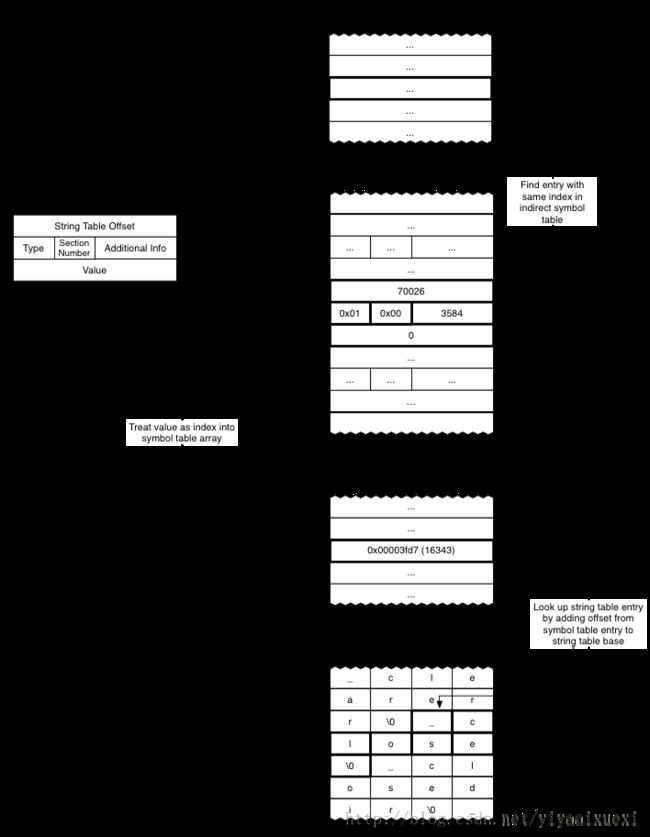iOS安全攻防(十七):Fishhook
Fishhook
众所周知,Objective-C的首选hook方案为Method Swizzle,于是大家纷纷表示核心内容应该用C写。
接下来进阶说说iOS下C函数的hook方案,先介绍第一种方案————fishhook .
什么是fishhook
fishhook是facebook提供的一个动态修改链接Mach-O符号表的开源工具。
什么是Mach-O
Mach-O为Mach Object文件格式的缩写,也是用于iOS可执行文件,目标代码,动态库,内核转储的文件格式。Mach-O有自己的dylib规范。
fishhook的原理
详见官方的How it works,这里我作个简要说明。dyld链接2种符号,lazy和non-lazy,fishhook可以重新链接/替换本地符号。
如图所示,__DATA区有两个section和动态符号链接相关:__nl_symbol_ptr 、__la_symbol_ptr。__nl_symbol_ptr为一个指针数组,直接对应non-lazy绑定数据。__la_symbol_ptr也是一个指针数组,通过dyld_stub_binder辅助链接。<mach-o/loader.h>的section头提供符号表的偏移量。
图示中,1061是间接符号表的偏移量,*(偏移量+间接符号地址)=16343,即符号表偏移量。符号表中每一个结构都是一个nlist结构体,其中包含字符表偏移量。通过字符表偏移量最终确定函数指针。
fishhook就是对间接符号表的偏移量动的手脚,提供一个假的nlist结构体,从而达到hook的目的。
fishhook替换符号函数:
int rebind_symbols(struct rebinding rebindings[], size_t rebindings_nel) {
int retval = prepend_rebindings(rebindings, rebindings_nel);
if (retval < 0) {
return retval;
}
// If this was the first call, register callback for image additions (which is also invoked for
// existing images, otherwise, just run on existing images
if (!rebindings_head->next) {
_dyld_register_func_for_add_image(rebind_symbols_for_image);
} else {
uint32_t c = _dyld_image_count();
for (uint32_t i = 0; i < c; i++) {
rebind_symbols_for_image(_dyld_get_image_header(i), _dyld_get_image_vmaddr_slide(i));
}
}
return retval;
}
关键函数是 _dyld_register_func_for_add_image,这个函数是用来注册回调,当dyld链接符号时,调用此回调函数。 rebind_symbols_for_image 做了具体的替换和填充。
fishhook替换Core Foundation函数的例子
以下是官方提供的替换Core Foundation中open和close函数的实例代码
#import <dlfcn.h>
#import <UIKit/UIKit.h>
#import "AppDelegate.h"
#import "fishhook.h"
static int (*orig_close)(int);
static int (*orig_open)(const char *, int, ...);
void save_original_symbols() {
orig_close = dlsym(RTLD_DEFAULT, "close");
orig_open = dlsym(RTLD_DEFAULT, "open");
}
int my_close(int fd) {
printf("Calling real close(%d)\n", fd);
return orig_close(fd);
}
int my_open(const char *path, int oflag, ...) {
va_list ap = {0};
mode_t mode = 0;
if ((oflag & O_CREAT) != 0) {
// mode only applies to O_CREAT
va_start(ap, oflag);
mode = va_arg(ap, int);
va_end(ap);
printf("Calling real open('%s', %d, %d)\n", path, oflag, mode);
return orig_open(path, oflag, mode);
} else {
printf("Calling real open('%s', %d)\n", path, oflag);
return orig_open(path, oflag, mode);
}
}
int main(int argc, char * argv[])
{
@autoreleasepool {
save_original_symbols();
//fishhook用法
rebind_symbols((struct rebinding[2]){{"close", my_close}, {"open", my_open}}, 2);
// Open our own binary and print out first 4 bytes (which is the same
// for all Mach-O binaries on a given architecture)
int fd = open(argv[0], O_RDONLY);
uint32_t magic_number = 0;
read(fd, &magic_number, 4);
printf("Mach-O Magic Number: %x \n", magic_number);
close(fd);
return UIApplicationMain(argc, argv, nil, NSStringFromClass([AppDelegate class]));
}
}
注释//fishhook用法 处
rebind_symbols((struct rebinding[2]){{"close", my_close}, {"open", my_open}}, 2);
传入rebind_symbols的第一个参数是一个结构体数组,大括号中为对应数组内容。
不得不说,facebook忒NB。
